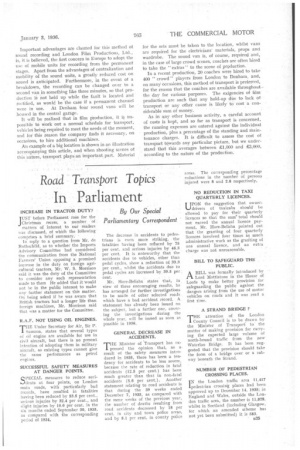Road Transport Topics
Page 45

If you've noticed an error in this article please click here to report it so we can fix it.
In Parliament
• By Our Special Parliamentary Correspondent
INCREASE IN TRACTOR DUTY?
"UST before Parliament rose for the J Christmas recess, a number of matters of interest to our readers was discussed, of which the following comprises a brief summary.
In reply to a question from Mr. de Rothschild, as to whether the Imports Advisory Committee had considered the communication from the National Farmers' Union opposing a promised increase in the duty on foreign agricultural tractors, Mr. W. S. Morrison said it was the duty of the Committee to consider any such representation made to them He added that it would not be in the public interest to make any further statement on this matter. On being asked if he was aware that British tractors had a longer life than foreign machines, Mr. Morrison said that was a matter for the Committee.
R.A.F. NOT USING OIL ENGINES.
THE Under Secretary for Air, Sir P.
Sassoon, states that several types of oil engine are available for use in civil aircraft, but there is no present intention of adopting them in military aircraft, as existing types cannot give the same performance as petrol engines.
SUCCESSFUL SAFETY MEASURES AT DANGER POINTS.
SPECIAL measures to reduce accidentsdents at four points, on London main roads, with particularly bad records, have resulted in fatalities having been reduced by 53.5 per cent.. serious injuries by 32.4 per cent., and slight injuries by 10.6 per cent, in the six months ended September 30, 1935, as compared with the corresponding period of 1934.
The decrease in accidents to pedestrians is even more striking, the fatalities having been reduced by 75 per cent, and serious injuries by 46.3 per cent. It is noteworthy, that the accidents due to vehicles, other than pedal cycles, show a reduction of 33.3 per cent., whilst the accidents due to pedal cycles are increased by 39.5 per cent.
Mr. Hore-Belisha states that, in view of these encouraging results, he has arranged for further investigations to be made of other selected roads which have a bad accident record. A statement has already been issued on the subject, but a further one, covering the investigations during the whole year, will be issued as soon as possible in 1936.
GENERAL DECREASE IN ACCIDENTS.
'THE Minister of 'Transport has ex
pressed the opinion that, as a. result of the safety measures introduced in 1935, there has been a tendency for accidents to be less severe, because the rate of reduction in fatal accidents (12.5 per cent.) has been much greater than that in non-fatal accidents (5.6 per cent.). Another statement relating to road accidents is that during the 39 weeks ended December 7, 1935, as compared with the same weeks of the previous year, the number of deaths resulting from road accidents decreased by 18 per cent, in city and town police areas, and by 8.1 per cent, in county police
areas. The corresponding percentage reductions in the number of persons injured were 8 and 2.6 respectively.
NO REDUCTION IN TAXI QUARTERLY LICENCES.
UUPON the suggestion that ownerdrivers of taxicabs should be allowed to pay for their quarterly licences so that the sums total should not exceed the annual licence payment, Mr. Hore-Belisha pointed out that the granting of four quarterly licences involved four times as much administrative work as the granting of one annual licence, and an extra charge was not unreasonable.
BILL TO SAFEGUARD THE PUBLIC.
ABILL was formally introduced by Lord Mottistone in the House of Lords to make better provision for safeguarding the public against the clangers arising from the use of motor vehicles on roads and it was read a first time.
A STRAND BRIDGE?'
-r-TE attention of the London 1 County Council is to be drawn by the Minister of Transport to the matter of making provision for carrying the expected large volume of north-bound traffic from the new Waterloo Bridge. It has been suggested that the provision should take the form of a bridge over or, a subway beneath the Strand.
NUMBER OF PEDESTRIAN CROSSING PLACES.
I N the London traffic area 11,417 pedestrian crossing places had been approved up to December 14, 1935: in England and Wales, outside the London traffic area, the number is 11,828, whilst in Soctland (including Glasgow, for which an amended seheme has not yet been submitted) it is 583.




















































































